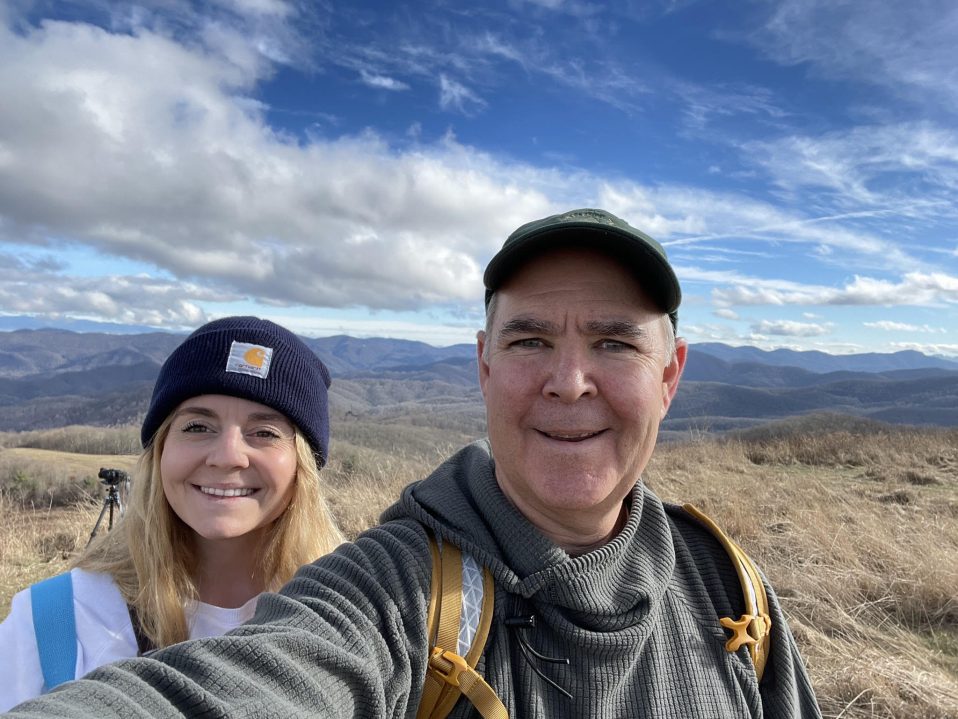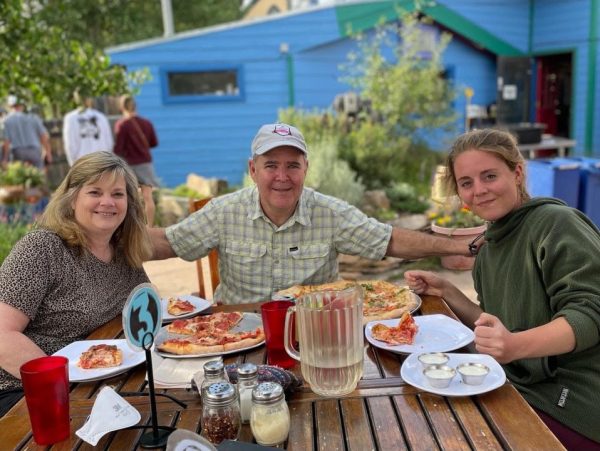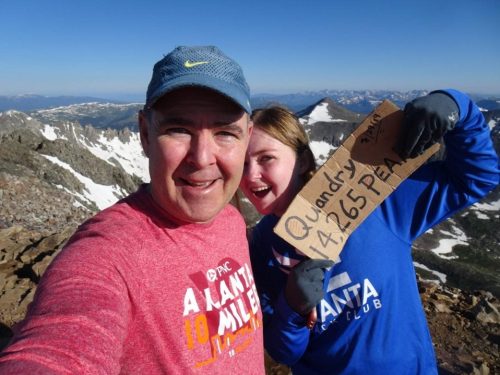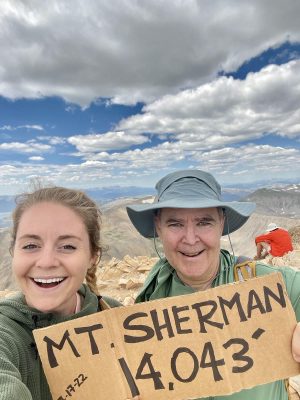Blog
“Fatherhood is My Driving Force.” Greg Patterson’s Vasculitis Story

Greg Patterson, who describes himself as a “weekend warrior long-distance runner,” was in the middle of the Peachtree 10K Road Race in Atlanta, Georgia, last July when he and his two daughters (who were running with him) stopped momentarily to walk. They had been running the race together for about 10 years and knew the stretch on the course where an Episcopal priest sprinkles runners with holy water. Greg laughed as he told me: “That year, I knew we needed it. I said, ‘Let’s make sure we’re doused really good!’”
Greg considers himself a “blessed person.” He was an amateur runner, backpacker, and hiker. He was active with work as a physical therapist (PT) and adjunct faculty member at a local PT program. “Whatever I wanted to do,” he told me, “I could.”
 In 2021, he got what he thought was a bad sinus infection. An ENT gave him antibiotics and steroids, but his symptoms only worsened, morphing into bleeding and difficulty breathing. That’s when they knew something else was going on. The ENT did a biopsy; it was confirmed. Greg had granulomatosis with polyangiitis (GPA).
In 2021, he got what he thought was a bad sinus infection. An ENT gave him antibiotics and steroids, but his symptoms only worsened, morphing into bleeding and difficulty breathing. That’s when they knew something else was going on. The ENT did a biopsy; it was confirmed. Greg had granulomatosis with polyangiitis (GPA).
Greg, his wife, and their two daughters live in a small town in Georgia. “All of us in the medical community are pretty tight,” he said. “It’s normally months to get into a rheumatologist; my friend got me in the next day.” He was lucky: he got treatment fast.
In fact, Greg figured it would be smooth sailing from there: “I thought I was going to be the poster child of vasculitis.” He returned to running, went on a hiking trip with his buddies to the Grand Canyon. But then his hip started bothering him. It turns out the prednisone he was on for his vasculitis had created small gastrointestinal tears. Fluid from his abdominal cavity was leaking into his hip and leg, causing a nasty infection. He went through two surgeries and lost significant muscle mass on that side. “Then I got sepsis,” he said. “There were some touch-and-go days.” He realized this disease was a bigger opponent than he had thought.
Greg and his two daughters, MaryClaire (26) and Madilyn (24), have been running together since the girls were young. MaryClaire is “committed, sticks to it, and is detail-oriented like her mother.” Madilyn is “adventuresome, everyone knows her. She takes life by the reins and doesn’t let go.”
 As soon as they were old enough, the three of them started doing one-mile races, then three miles, then 5Ks and 10Ks. Eventually, they ran half-marathons and marathons togethers. “It’s been one of the things that defines our family,” Greg said. While Greg and his daughters are on the course together, he insists his wife is their “anchor. She’s our shuttle driver, water person, the one who meets you at the finish line. We couldn’t do it without her.”
As soon as they were old enough, the three of them started doing one-mile races, then three miles, then 5Ks and 10Ks. Eventually, they ran half-marathons and marathons togethers. “It’s been one of the things that defines our family,” Greg said. While Greg and his daughters are on the course together, he insists his wife is their “anchor. She’s our shuttle driver, water person, the one who meets you at the finish line. We couldn’t do it without her.”
After Greg’s surgeries, sepsis, and significant muscle loss, doctors weren’t sure he’d ever get back to running, the activity that had shaped his bond with his daughters. But he was determined. With the help of a physical therapist friend, he started rehabbing himself, building strength.
A few years earlier, his oldest daughter, MaryClaire, had gotten them into climbing fourteeners in Colorado. These are mountain peaks with an elevation of at least 14,000 feet. Before he got sick, Greg and MaryClaire had completed two fourteeners in honor of her undergraduate graduation; they had planned on doing more. As Greg was recovering, he held tight to that vision: “That gave me something to shoot for. I was out of work for three months; on a walker for over a month.” He wouldn’t give up. Slowly, he started walking, then run-walking.
“Being a dad has been one of my most driving forces to keep me going,” Greg said. With MaryClaire and Madilyn in mind, he persisted. Last July, they summited a fourteener together in Leadville, Colorado.
 “Being a father,” Greg said, “is a real honor and gift.” He’s learning what love and parenting mean as his daughters grow up and into their own lives. He’s practicing when to lean in, when to lean back, how much. He grew up around his grandparents’ farms and he considers parenting “kind of like farming. You prepare the soil, you plant the seeds, you fertilize, you weed. When the crops start coming in, bugs might be on them here and there, there may be some weeds,” but it’s still a glorious experience. “You learn not to have as many weeds next year. In fact, you’re always learning. Maybe that’s the biggest lesson of fatherhood, maybe that’s the beauty of it: you’re never done. It leads you to a rich life of always trying to learn, to grow, to find ways to be a better parent and person.”
“Being a father,” Greg said, “is a real honor and gift.” He’s learning what love and parenting mean as his daughters grow up and into their own lives. He’s practicing when to lean in, when to lean back, how much. He grew up around his grandparents’ farms and he considers parenting “kind of like farming. You prepare the soil, you plant the seeds, you fertilize, you weed. When the crops start coming in, bugs might be on them here and there, there may be some weeds,” but it’s still a glorious experience. “You learn not to have as many weeds next year. In fact, you’re always learning. Maybe that’s the biggest lesson of fatherhood, maybe that’s the beauty of it: you’re never done. It leads you to a rich life of always trying to learn, to grow, to find ways to be a better parent and person.”
Over the past two years since his vasculitis diagnosis, Greg has struggled not to feel like he’s putting a burden on his family. This process of asking for help and bringing them into his experience has been a revelation: “I’m learning to embrace the fact that they’re there to be a part of my journey. They give me the strength I need.”
He encourages other fathers with vasculitis not to shy away from the strength and support of their families. “Welcome the gift you’ve been given of being a dad. Continue to live and experience life together with your kids and family. It will only strengthen you and your bond.” He insists, “We were never promised life was going to be easy. We all want a quick fix; we want Amazon to deliver today, we want life on demand. But the struggles in life are where you truly grow – and where you grow together.”
For Greg and his family, they have “found strength and escape in the natural world…It could be your local city park or a 14,000-foot mountain in Colorado. No matter what,” he says, “embrace the gift of your family.”
Greg knows the secret: we need each other. In struggle and in joy, lean in.
Author: Ashley Asti

